
More businesses, bloggers, and solopreneurs want to get on Pinterest these days as it drives more traffic. Their experience with social media platforms like Instagram and Facebook leaves them disappointed. These sites hoard traffic and try to retain users on their site for as long as possible.
While Pinterest is a mix of a social network and search engine that sends traffic. But many businesses have no idea how to use it. The boards, tall images, keywords, and insights confuse them.
This is why there’s a massive demand for Pinterest managers that can help them. I got into it early, and I was fortunate enough to help brands like CrazyEgg and Onsen Secret with their Pinterest marketing.
What is a Pinterest manager?
Simply put, a Pinterest manager is someone who manages a Pinterest account (or executes other Pinterest marketing tasks) on behalf of a business or individual. The Pinterest manager creates a strategy, designs images, schedules pins, and conducts various other duties to build a solid presence on the network.

The business can focus on what it’s good at (running the company), while the Pinterest manager helps it reach its marketing goals. This can be to drive traffic or build a brand image or generate sales.
As a Pinterest manager, you can work from home or on-site. This is true whether you work on your own or for someone else. Many companies and agencies allow you to work from anywhere you please.
How much does a Pinterest manager make?
A lot of factors will determine how much you make as a Pinterest manager.
If you work full-time at an agency or a company, you’ll make between $41,000 to $71,000, depending on your experience, location, and amount of work.
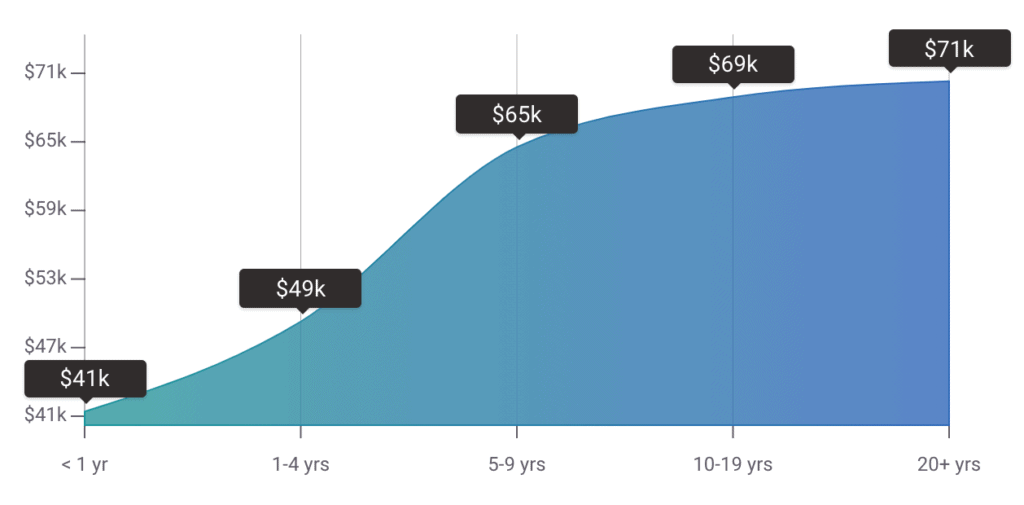
That’s how much the average social media manager gets.
If you freelance, a lot of other factors will affect your earnings. These include the quality of clients you work with, the number of clients, services you offer, and how much you charge.
- For setting up an account, I’ve seen people charge as little as $50 and as high as $1000.
- For managing an account, I’ve come across packages that were less than $100 per month and as high as $3,000 per month.
- Pinterest ads management ranges from $500 to $2,500 per month. Some managers charge by the percentage of ad spend. It usually starts at around 25% and goes down as the ad spend increases.
- For consulting and coaching, I’ve seen rates as low as $20 per hour and as high as $500 per hour.
I’ve even come across a couple that charge $3,000 per hour. But these two were at the top end and had a proven track record illustrated with testimonials and case studies.
You’ll usually start at the low end. After you gain some experience, you can increase your pricing and attract clients who will pay better. If you already have experience, you can get there swiftly.
Another factor that’ll determine how much you make overall is whether you run your businesses as an individual or an agency. If you run it as an agency, your revenue will be significantly higher.
What does a Pinterest manager do?
Here are the different things a Pinterest manager does.
Pinterest business account set up
Setting up an account on most social networks is straightforward. You upload a profile picture and cover image and add other content. While on Pinterest, you require a few more steps, such as finding keywords, creating boards, and optimizing the boards and profile with these keywords.

It can get confusing for someone new. This is why there’s a huge demand for Pinterest managers who can set up well-optimized pages.
Some companies will hire you to fix their pages. You’ll need to change the display visuals, update keywords and optimize pins. This is popularly known as an “account clean-up.”
Pinterest management services
After you set up the account, businesses will want you to manage the account. You’ll need to create a content strategy, develop a scheduling plan, manage group boards, create images and do keyword research for descriptions.
You’ll also need to dissect data from Pinterest and Google Analytics and use it to improve the management plan.
Most people will hire you for management. This will be the bulk of the work. So, get good at it. Your focus should be on understanding how Pinterest’s algorithm works and how to beat it. You’ll also need to formulate different packages depending on the number of pins you post and images you create.
You might even want to get yourself familiar with Pinterest scheduling tools.
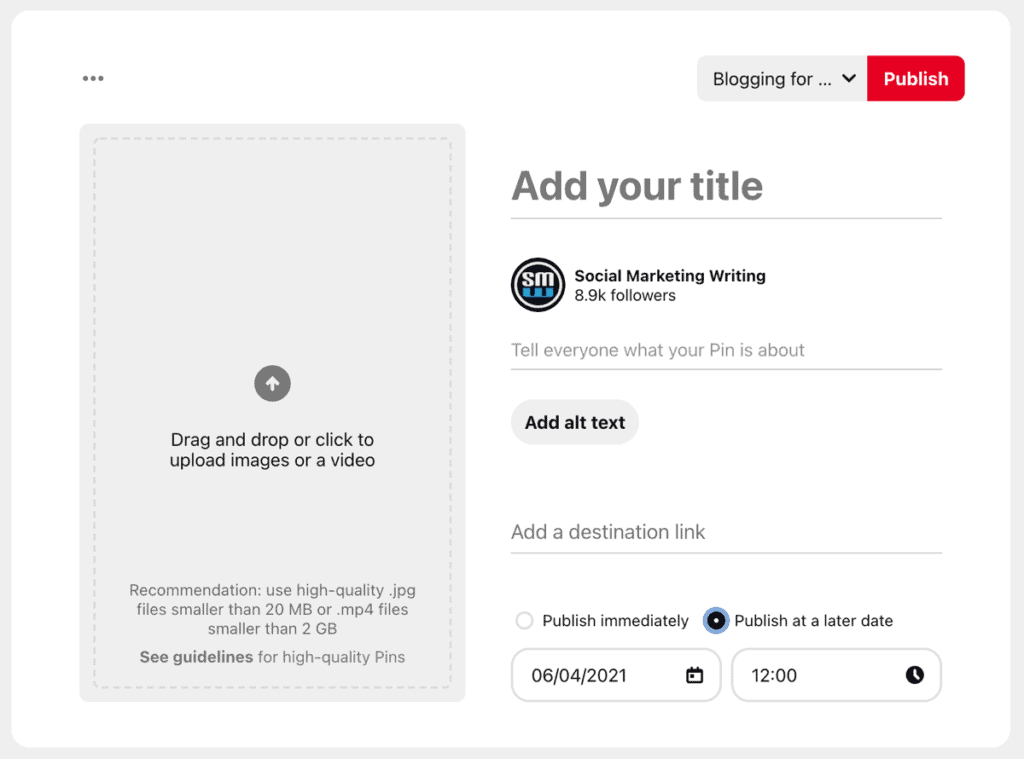
Pinterest now lets you schedule manually, but if you’re managing many accounts, it can take up more time.
For those juggling multiple accounts and boards, Circleboom’s intuitive Pinterest scheduler simplifies this task. It offers a centralized dashboard from which you can easily manage your Pinterest presence. This consolidation is invaluable for marketers and content creators looking to maintain a cohesive strategy across various niches or brands.
The Pinterest Hashtags Generator is another gem in Circleboom’s crown, taking the guesswork out of engagement. Recommending relevant hashtags amplifies your pins’ reach, connecting your content with the right audience and maximizing visibility in Pinterest’s algorithmic tide.
Another popular Pinterest scheduler is Tailwind. It comes with features such as multiple account management, board lists, and bulk scheduling that can save time.
Pinterest SEO
Pinterest is both a social network and a search engine. This is why one of your tasks will be to conduct keyword research.
You’ll need to optimize the profile, board descriptions, and pin descriptions with these keywords.
Create Pinterest Marketing Strategies
For successfully marketing themselves on Pinterest and tracking their efforts and performance, businesses require a marketing strategy. As a Pinterest manager, you’ll need to do a lot of research, audit their account, and develop a strategy that works.
Some businesses will just want you to create a strategy they can use. At the same time, others will want you to create and implement it. And, of course, others will want you to do a simple audit.
Pinterest ads management
Many businesses will want to get quick results or supplement their organic efforts with paid ones to scale results. Pinterest is an excellent network for this as the average order value (AOV) for ads on the network is $154.
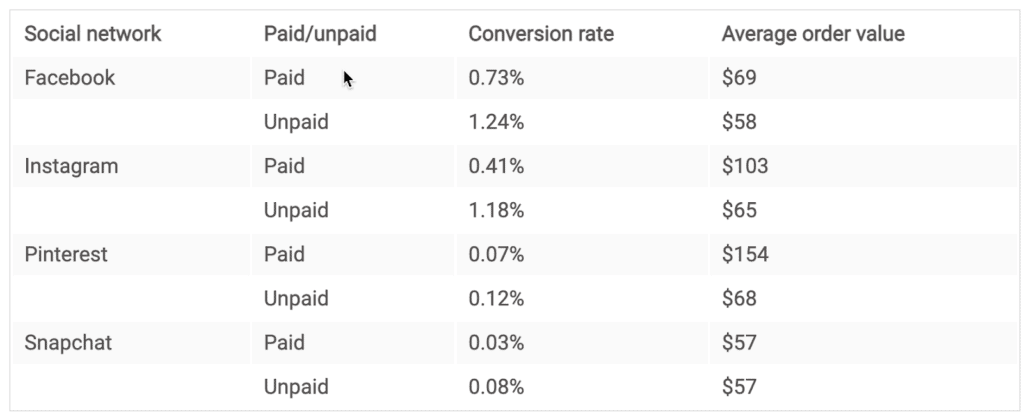
It’s higher than Instagram and other top networks. This is why there’s a good demand for Pinterest ads management services.
Pinterest image creation
You can separately create and sell Pinterest images, as not everyone gets this right. Images on this site need to be tall and clickable (if the goal is to drive traffic). If your aim is engagement, your pins should get more repins. The ideal size is 600 X 900 pixels.

Some people even sell templates and make money. It can be a passive source of income or part of your entire marketing funnel.
One on one coaching:
Several businesses will prefer hiring you for one on one or group coaching so that you can teach them how to manage their accounts. Even amateur Pinterest managers who want to get started will be interested in this service.
All Pinterest managers don’t offer all of the tasks above. Some like to specialize in a few.
How to become a Pinterest manager?
There’s a lot of demand for the above services. But getting people to hire you requires some work. They will only hire you and pay you well if you’re good and bring in stellar results. This is why I’m going to show you how to become a Pinterest manager that people want to work with below.
Learn all about Pinterest marketing
In the beginning, you need to know all the ins and outs of using Pinterest. After you do that, you can specialize in using Pinterest for business. Here are a few ways to go about that.
Hire a coach
The quickest way to become a Pinterest manager or learn any other skill is to hire a coach to help you out. A coach will not only give you strategic advice, but also correct you when you make mistakes.
Pick your coach depending on whether you want to run a simple freelancing business or grow a full-fledged agency. Your coach should be where you want to be (or should have been there in the past). They can enlighten you with all the knowledge necessary.

Only go with this option if you have a high budget. As the top coaches usually charge thousands of dollars. It’s worth every penny, as you’ll acquire the necessary knowledge to do Pinterest marketing and get clients quickly.
Take a course:
If you don’t want to spend thousands of dollars on a coach, you can buy a good course for a few hundred dollars or get a free one. Here are a few good courses you might want to check out…
Pinning perfect

Pinning Perfect is the ideal course for anyone who wants to learn organic Pinterest marketing.
This course will show you how to create strategies, images, accounts, and so much more. There are some bonuses like a free Tailwind account and image templates. A lot of top Pinterest bloggers and marketers used it.
SImple Pin Collective

If you want something more than a course, you should get Simple Pin Collective. It’s a membership program. Every month you get a new training video and action steps. You also have access to feedback, monthly coaching calls, past recordings, and various other bonuses.
Kate Ahl created Simple Pin Collective. Kate also owns Simple Pin Media, which is one of the most successful Pinterest marketing agencies.
Social Media Manager School

If you want to become a complete social media manager, you should get Social Media Manager School. This course will teach you both – how to market on various social media and how to attract good clients.
You might also want to check out YouTube as there are hundreds of tutorials on Pinterest marketing there.
Read books and blogs:
If courses are out of your budget, too, you can just read some books and blog posts. You can find a lot of the information you find in courses through blog posts and books, but it’ll take you longer. For good articles, just conduct an online search. Here are some sites you might find helpful.
While for books, you can either use Amazon or Scribd.

If you use my special link to sign up for Scribd, you’ll get your first two months for free.
Set up your own Pinterest account, practice, and experiment
Coaching, courses, and books will give you a good starting point, but they aren’t the best way to learn. The only way you’ll learn is if you manage a Pinterest account.
Create one or two of your own and practice on them. Use the tips you absorbed from courses, books, or coaching to set up your account and manage it. This is how I learned.

While doing this, feel free to experiment and make mistakes. It’s better to mess up on your accounts than on your clients.
You can also use this account as a case study to attract new clients.
Get Tailwind
Most scheduling tools like Buffer, Hootsuite, and CoSchedule offer Pinterest scheduling these days. But these schedulers were made for scheduling to networks such as Facebook and Twitter. They only added Pinterest scheduling later. This feature isn’t very robust as Pinterest is a unique network with boards, SEO, and other elements.
The only scheduling software specially created for Pinterest marketing is Tailwind. It’s got features like Pinterest create for automating image creation, board lists, intervals, bulk upload, and tribes that other tools don’t have.
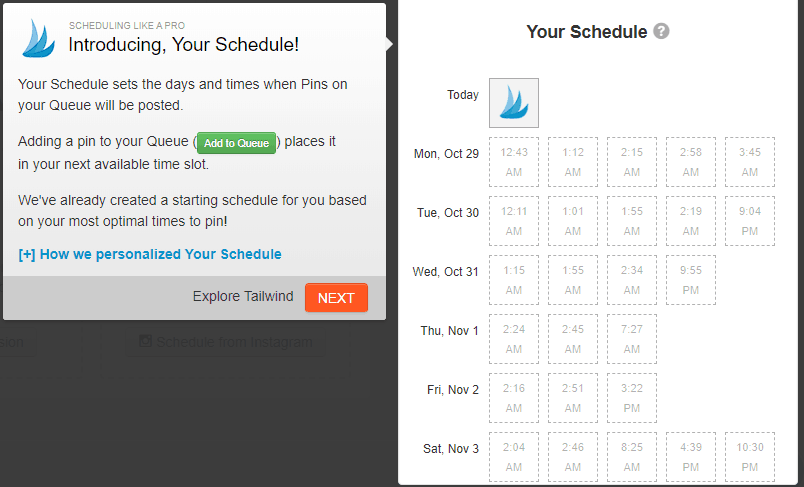
You should get this tool if you’re serious about Pinterest management. It’ll also show potential clients that you have the equipment to offer the best service. Practice using Tailwind on your account before you begin using it on your clients’ accounts. You get the first 100 pins for free. Here’s a guide to get started.
Create templates, checklists, and workflows
You’ll need to create a lot of images as a Pinterest manager. On top of that, you’ll need to develop go-to processes for tasks like audits and strategies. You can cut short this time by creating templates and workflows ahead of time.
You can quickly develop these with tools like Canva and InDesign or buy the templates from other sources.
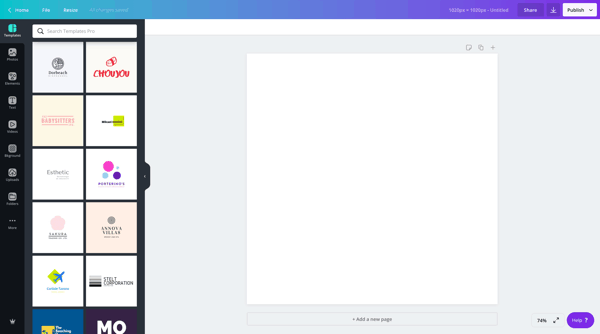
If you want something to get started with, you can download these free social media templates I made. It has templates for Pinterest, Instagram, blogs, Facebook, and other networks.
Templates, workflows, and processes will save you time. This will make it easy to take on more clients and onboard them quickly.
Decide what type of manager you want to be
Once you have the skills, you can look for work. But before you go about it, it’s vital to decide what type of manager you want to be. This will help brand yourself correctly and attract the right clients.
A complete social media manager
Most people prefer to become complete social media managers as there’s more demand for them. Companies prefer working with someone who can handle their entire social media. Instead of hiring different social media managers for different social media. This will make it easy for you to find work. Also, you can upsell services to people who initially hire you for one social network.
If you want to manage all social media, instead of restricting yourself to Pinterest management, you should consider this.
A manager specializing in Pinterest marketing exclusively
The main benefit of becoming a specialist Pinterest marketer is that you’ll spend all your time marketing on Pinterest. This will help you gain a lot of knowledge quickly. Many businesses that want a top Pinterest expert will gravitate towards you. And you can also charge more.
You can go even further and decide whether you want to be a Pinterest ads manager or an organic expert. Some people like to specialize in more zoned niches such as ecommerce and coaching. Others get even more specific and specialize in platforms/sites such as Etsy, Shopify, and WordPress.
For some inspiration, check out Mary Lumley.
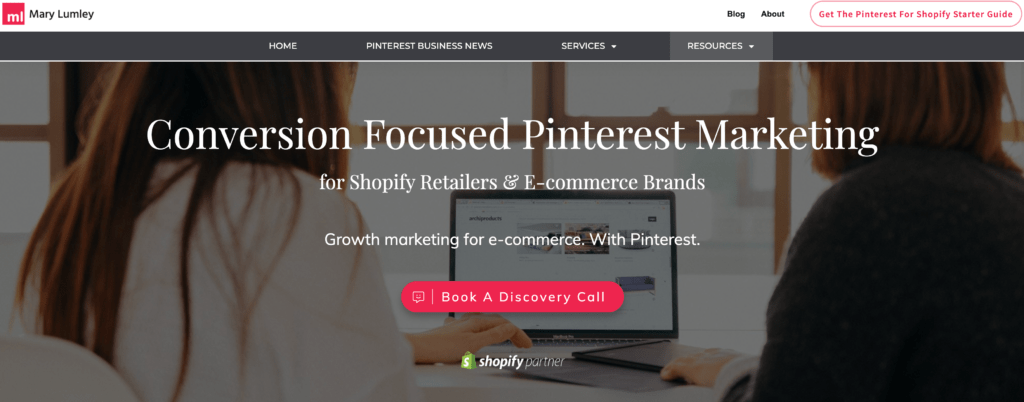
Mary’s focused on serving Shopify retailers and ecommerce brands with their paid advertising and organic Pinterest marketing needs. This has helped her carve out a niche and stand out from the competition.
A Pinterest virtual assistant
If you want to work for a Pinterest manager or want to be a freelance manager that charges less, a Pinterest virtual assistant would be a better path. A Pinterest virtual assistant will offer all services as a Pinterest manager, but the main difference is that they’ll cater to small businesses and freelancers with smaller budgets.
When you’re starting, you can work as a freelance virtual assistant or for an agency. Then gradually, graduate into a Pinterest manager.
Do you want to work for someone or go freelance?
Once you know what type of manager you want to be, you need to decide if you want to work for someone or go freelance and run your own business. You’ll find that most people online recommend you to become a freelance Pinterest manager. But don’t listen to what they all say. You should choose what’s best for you.
I went the self-employed route as I prefer that. You’ll probably make more if you work freelance, but at the same time, you’ll put in more work. As you need to handle many tasks other than managing accounts. These include finding clients, managing your finances, outsourcing tasks, and managing clients. It can also get stressful as you’ll be directly responsible for your clients’ results.

If you don’t want to worry about all of this, you can simply work for an agency or a company. They’ll find and manage clients. You’ll need to just manage the accounts. It requires less work, and it’ll keep your stress levels low. Of course, cutthroat agencies might pressure you and stress you out. So, be careful who you work with.
You can also work full-time for someone, but run a freelance management service as a side hustle.
How to find clients
I’m not going to discuss much on finding a full-time job as it’s pretty straightforward. You look for jobs online, apply, and ace interviews. But I will go into detail on how to find clients. That’s my area of expertise.
Reach out to business owners and bloggers
Getting the first client is the hardest as you don’t have much proof of your capabilities. You can always use your account as an example and try to convince people to hire you. As you land clients and get some proof, you can use it to get more clients.
Try to reach out to business owners and bloggers you know in the beginning either through email outreach or a phone call. Once you exhaust that, you can do cold outreach. Target bloggers, ecommerce stores, or online business owners. They usually want traffic from Pinterest.
If you want to get even more specific, look for businesses in the DIY, home, fashion, or food space as these topics are prevalent on Pinterest.
Work as a Pinterest VA
If you find it hard to get clients with the above method, you can brand yourself as a Pinterest VA initially. As a Pinterest virtual assistant, you’ll charge less, so more people will want to work with you. Many agencies and freelancers like to outsource their services to VAs.
After you gain a few clients and have results, you can overhaul your branding to a manager and charge more.
Work for free and get a case study
Another tactic that I recommend above everything else is to work for free for a big brand in your niche and get them outstanding results. Then, display the results with a case study like this one and use it to get more clients.
Here’s how I would do this…
First, choose an industry. This could be food, pets, fashion, health & fitness, or something else. Then pick a business type. This can range from bloggers, ecommerce, consultants, or another one where you want to build a foothold.
After that, choose a company that hasn’t built any presence on Pinterest, but could potentially thrive on it. I did some basic research and found Iceland, a supermarket in the UK.

It’s a big brand, and its website gets 9.5 million visits a month, according to SimilarWeb.

But its Pinterest presence is negligible.

Source: Pinterest
It only has 284 followers and 74 monthly views. Also, the site isn’t getting much traffic from Pinterest.
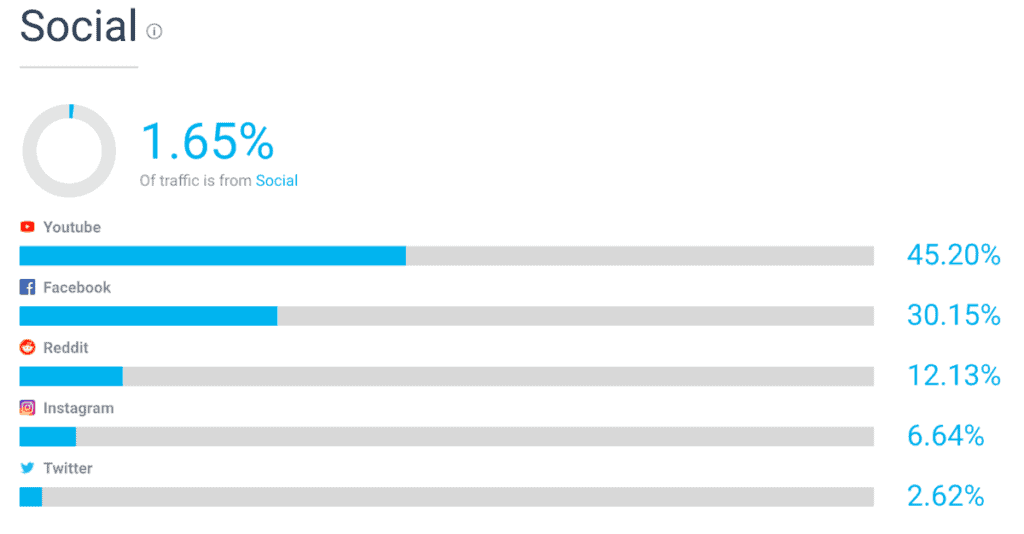
But when you look at one of its competitors, Sainsbury’s, the site has a massive presence on Pinterest.
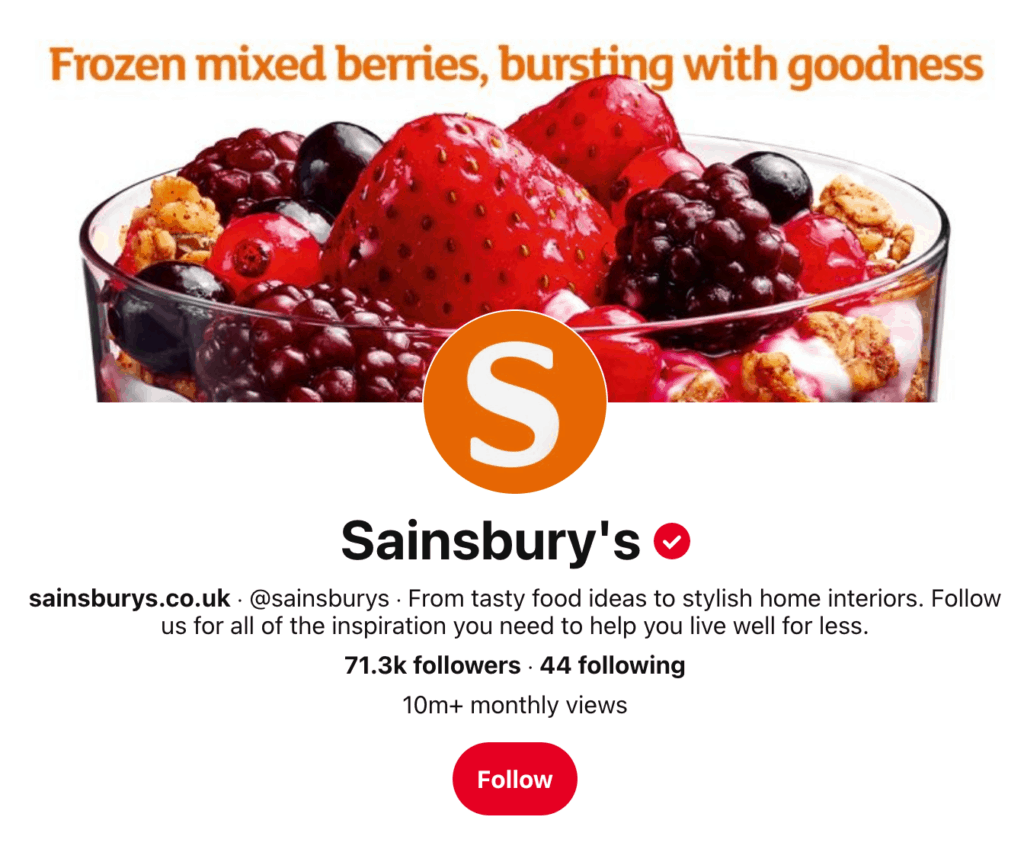
It has 71,300+ followers, 10+ million monthly views, and 5% of its social media traffic is from Pinterest.
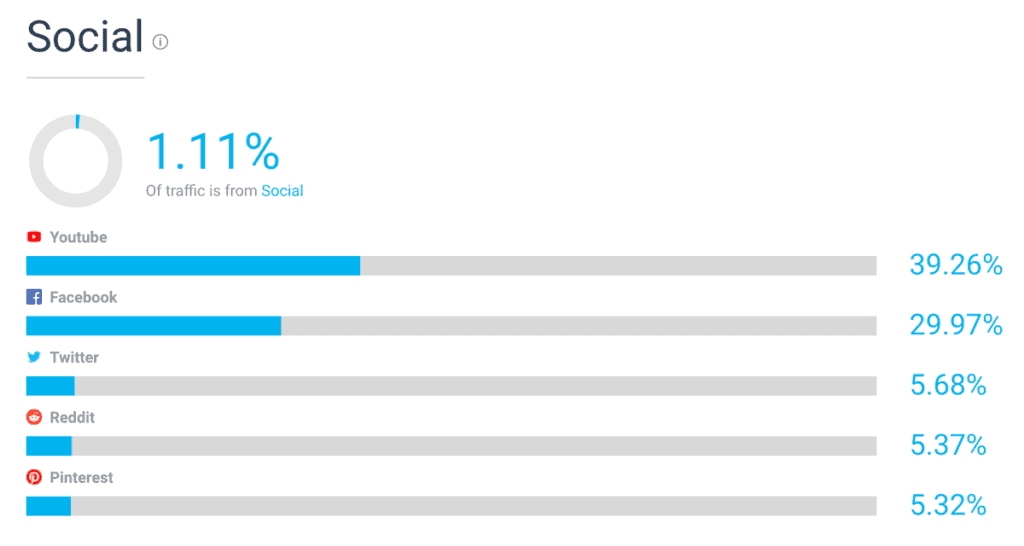
This might seem like a small number, but Sainsbury’s gets 25+ million visits a month. Pinterest is contributing several thousands of visits a month and probably sales too.
I also found that other competitors like Ocado, Waitrose, and Tesco have a solid Pinterest presence.
What you should do is come with a Pinterest marketing plan and contact the head of marketing or social media marketing at Iceland. You can find them on LinkedIn or with an email finder tool. Arrange a quick call or just email them the plan saying that their Pinterest presence needs an upgrade.
Then you should show them how you’ll help improve it and get them to a specific goal. This could be traffic or sales, or engagement. You need to be precise, as these people are very busy. You don’t want to give them extra work thinking about what tasks to assign to you.
Finally, tell them that you’ll do it for free. You won’t charge them a penny. But let them know that you’ll make a case study from the results you generate. Confirm that they’re okay with you displaying the before and after data and giving you a testimonial/quote.
You can then take this case study and use it in your cold outreach or integrate it into your marketing funnel and get new clients that’ll pay you well to get results like that one.
You can then make case studies out of these and boost your credibility further. An example is the collection of case studies on KlientBoost’s (an ad agency) website.
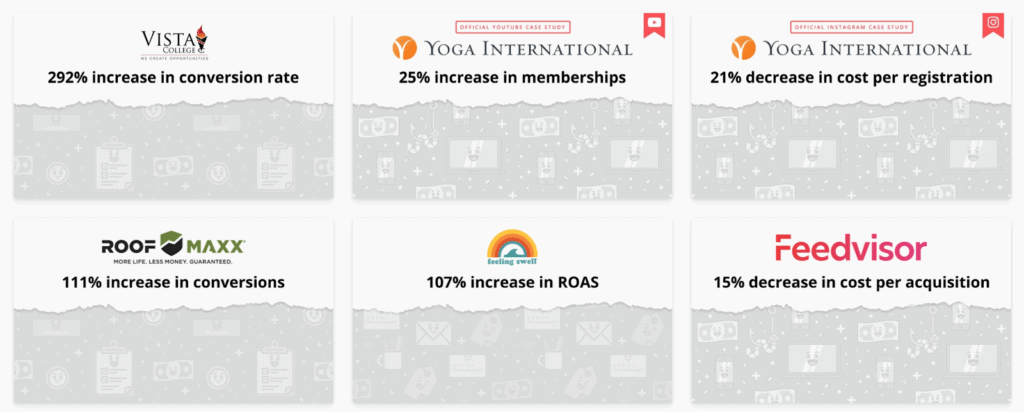
Look at all of them. They make the agency appear so credible. You’d be crazy not to work with them if you were a business looking for an ad agency.
Start a blog:
Another way to boost credibility is through blogging. I’ve written about Pinterest extensively on my blog and top sites like Social Media Examiner for over a decade. This has helped me attract clients, grow my email list, and gain guest posting opportunities on many other sites.
Blogging alone will help a bit. But if you want to get the most out of it, combine it with a case study or two.
Try a freelance site
Another way to get clients is to try freelance sites like Fiverr or Upwork. These sites are usually very competitive, and a lot of companies there are looking for a bargain. You might need to lower your prices for a bit. But it’ll be a good starting point to get some case studies.
If you want a premium site, you can check out Pangea or Markethire. They work with top freelancers and clients.
Run a pay per lead service
A pay per lead service is a business model where companies pay you per lead at the end of a time period instead of paying you an amount for a service or time.
For example, let’s say a company wants 1,000 leads per month, and they are okay with paying $5 per lead, then you get $5,000 at the end of the month when you deliver the leads. Many businesses prefer a pay per lead deal as there’s no risk for them. They’re only paying you for genuine leads.
If you offer this service, make sure you get good at Pinterest ads, as there are only so many leads you can get organically. Also, have some capital to invest in ads.
You’ll also need to be careful about who you work with. They need to pay you when you deliver the leads. If you find the right clients, this will work well as a pay-per-lead service is very scalable.
Now become a Pinterest manager
Pinterest is a popular network. It recently climbed to 450+ million users. As long as people use Pinterest and it generates engagement and traffic, businesses will hire managers to help them out.
If you want to be the go-to manager for Pinterest marketing, you should use the tips I shared to improve your knowledge and get clients. Get started now!

